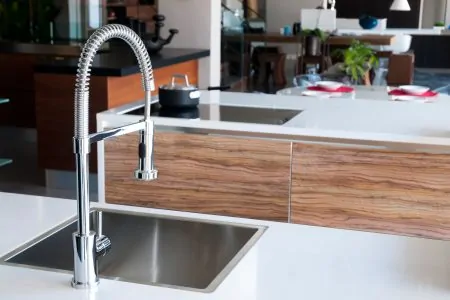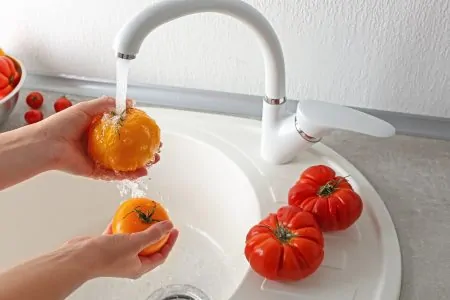Is there a permanent puddle of water at the base of your kitchen faucet? A leaking faucet can waste a huge amount of water if it isn’t dealt with.
On average, one leaky faucet in your home dripping 10 times a minute wastes about 3 liters of water per day. If it is allowed to keep dripping for a year, you are looking at about 347 gallons of water down the drain (1).
In this article, you can follow our simple step-by-step guide on how to fix a leaky kitchen faucet. We will tell you how to detect a leak, the different types of kitchen faucets, and how you can fix them.
Key Takeaways
- Identify the type of faucet: Compression, ball, cartridge, or ceramic disk faucets have different internal parts and require different repair methods.
- Turn off water supply: Always turn off the hot and cold water supplies before attempting any repairs, and drain the faucet to prevent water damage.
- Replace damaged parts: Common issues include worn or damaged o-rings, washers, and cartridges. Replace these parts as needed to fix the leak.
- Regular maintenance: To extend the life of your faucet, treat it with care, clean the aerator, and check for pressure drops or mineral build-up regularly.
How to Detect a Leak in a Kitchen Faucet
There are two main places where water can leak from a kitchen faucet:
1. Leaking From the Spout
This is the most obvious type of leak and should be easy to spot. You might notice a small drip from the faucet spout shortly after you turn the water off. Perhaps you find you need to turn the handle further to tighten it or move it to a specific position to prevent water from escaping.
Leaking from the spout tends to start slowly with an occasional drip and worsens over time. If you suspect you have a leaky faucet in its early stages, there are some easy ways to check.
You can dry the sink after use and place a paper towel beneath the spout. Alternatively, place a cup or another container directly under the spout. Leave it for a few hours, then check for moisture on the towel or water in the container.
2. The Base of the Faucet
This type of leak is less obvious. Water is unavoidably splashed around the base of the faucet when water is running, and it often pools on the sink deck.
To test for a leak in this area, dry the base of the faucet and the surrounding area. These leaks occur when water is flowing, so turn the faucet on and watch for water seeping from the bottom.
If there is leaking from the handle or leaking at the base, the issue is slightly more complicated to deal with, but you should be able to fix it without too much effort.
Different Types of Kitchen Faucets
Kitchen faucets are available in many different styles, both externally and internally. There are four main categories of kitchen faucets.
The compression faucet is easily spotted as it has separate handles for hot and cold water. The other three types (ball, cartridge, and ceramic disk faucets) all look similar externally, with a single handle, but their inner parts are different.
- Compression faucet: This has two handles, one for hot water and one for cold. The water usually comes from a central spout.
- Ball faucet: This faucet has a ball joint inside that controls water flow.
- Cartridge faucet: This faucet has a single cartridge under the handle.
- Ceramic disk faucet: A cartridge is under the handle, which has a ceramic disk.
What Causes a Faucet to Leak?
There are several reasons why you might have a leaky faucet. Four of the most common ones are:
O-Ring Issues
This issue is most commonly found in a cartridge faucet. A faucet handle is held in place by a stem screw, which has a small disc attached called an o-ring. This helps seal the faucet but frequent use can wear it down or loosen it. This then causes a leak near the handle.
Corrosion in the Valve Seat
Compression faucets have a valve seat that connects the spout to the water mechanism. Sediment and mineral deposits can cause this to corrode, causing a leak from the spout area.
Washer Wear
Every time you use your faucet, the internal washers are pressed against the valve seat. This causes friction, and the rubber will eventually wear down and lose its effectiveness. The result is a dripping tap as the water finds its way past the seal.
This is another common issue in compression faucets.
Incorrect Installation
When your faucet is installed, all seals and washers should be correctly placed. If they aren’t positioned correctly, water might be able to leak out of the faucet.
Top Tip
How to Fix a Leaky Kitchen Faucet
Warning
The valves to turn off the water to your faucets are usually located under the sink, on the pipes that connect to the faucet.
We recommend plugging the sink so you don’t drop any screws down the drain while you perform the necessary maintenance. Also prepare a clear area to place the parts in, ideally a container. You don’t want to misplace them.
Before reassembling your faucet after a repair, be sure to clean any build-up or debris inside. You can do this using white vinegar and a cloth. Failing to clean the faucet could make your maintenance far less effective.
Now we will take a step-by-step look at how to fix the different types of kitchen faucet.
Compression Faucet
What You Need
- Flathead screwdriver
- Phillips screwdriver
- Wrench
Step 1: Remove the Protective Cap Covering the Screw
There are usually plastic caps that indicate the handle controls hot or cold. These might be red or blue or have the letters “H” or “C” on them. You can pop the cap off with a flathead screwdriver.
Step 2: Lift off the Handle
Once the plastic cap has been removed, you should see a screw underneath. Use a Phillips screwdriver to remove the screw and then remove the handle.
Step 3: Unscrew the Nut
You should now see a nut at the base of the main stem the handle sits over. Use your wrench to loosen and remove this nut.
Step 4: Remove the Stem
Lift out the main stem of the faucet to reveal the seat washer and o-ring.
If you’re unsure which is which, the seat washer will be thicker than the o-ring and is held in place with a brass screw.
Step 5: Check for Wear and Damage
Examine the seat washer and o-ring for wear or damage.
If your faucet is dripping, it’s usually the o-ring at fault. If it leaks from the handle, the seat washer is to blame.
Step 6: Replace the Washer or O-ring
Visit your local hardware store and get a replacement washer or o-ring.
It’s a good idea to take the old ones with you to ensure you buy appropriate replacements.
Step 7: Reassemble your faucet
Put your faucet back together by reversing steps 1 to 4.
Use a small amount of plumber’s grease to lubricate the washer or o-ring.
Turn your water supply back on and test your handiwork. Any minor leaks should now be fixed.
Pro Tips
- Check for a loose nut: Sometimes a leak might be caused by a loose nut under the handle. Before turning off the water, remove the faucet handle as described in steps 1 and 2, then tighten the nut. If this stops the leak, you can simply reassemble the handle and enjoy a drip-free faucet.
- Plumber’s putty: If your stem assembly doesn’t have a washer, use a plumber’s putty to create a seal at the base of the stem.
Ball Faucet
What You Need
- The correct ball replacement kit for your brand of faucet. This kit should contain the parts and tools you need.
- Flathead screwdriver
- Wrench
- Needle-nosed pliers
- Pencil
Step 1: Remove the Protective Cap Covering the Screw
At the center front of the handle, you should see a protective plastic cap. It might be colored half red and half blue, or display the company logo. Prise it out gently using the flathead screwdriver.
Step 2: Lift Off the Handle
Use the Allen key supplied in your kitchen faucet repair kit to remove the screw that holds the handle. Once the screw is removed, remove the handle.
Step 3: Remove the Collar and Cap
Beneath the handle, you should see a cap and collar holding the ball assembly in place.
Use a wrench to loosen the cap and collar and remove them.
Step 4: Lift out the Cam
Using the tool supplied in your kit, remove the plastic cam. This looks like a round disc with a D shape in the middle.
There will be indents that the special tool fits into to make removal easier.
Step 5: Take out the Ball Assembly
Once the cam has been removed, the ball assembly can be easily lifted out.
Step 6: Remove the Seals and Springs
Beneath the ball assembly and each spring, you will see two o-rings. Use your needle pliers to lift them from the faucet.
Step 7: Renew the Seals and Springs
Take the new seals and springs from your kit and place them into the faucet.
You might find it easier to place them over the end of a pencil or flathead screwdriver to fit them.
Step 8: Replace the Ball Assembly and Cam
Replace the ball assembly and cam with the new parts, making sure they are correctly aligned.
Step 9: Reassemble the Faucet
Reverse steps 1 to 3 to reassemble your faucet. Turn the water supply back on to test your repair.
Pro Tip
Cartridge Faucet
What You Need
- Allen key
- Wrench
- Needle-nose pliers
- Phillips screwdriver
- Small flathead screwdriver
Step 1: Remove the Protective Cap Covering the Screw
Pop out the cap covering the screw that holds the handle in place.
Step 2: Detach the Handle
The screw holding the handle in place can be removed with an Allen key or a Phillips screwdriver, depending on the screw.
Remove the handle by tilting it away.
Step 3: Remove the Retaining Nut
Once the handle has been removed, a retaining nut should be exposed.
On some faucet models, you might need to remove a decorative collar, a plastic ring, and a stem washer to expose the retaining nut. Use your wrench or pliers to loosen the retaining nut and remove it by hand.
Step 4: Take Out the Retaining Clip
You will see a u-shaped clip that holds the cartridge in place.
Take this out by using a flathead screwdriver to loosen it or a pair of needle-nosed pliers.
Step 5: Pull out the Cartridge
Use pliers to pull the cartridge straight up by the stem.
This could require some force if mineral deposits have sealed it in place. You can try twisting it back and forth to free it.
Step 6: Replace the Cartridge
Take the old cartridge to your local hardware store and buy an appropriate replacement cartridge.
Secure it in the faucet by pushing it down and make sure it is correctly aligned.
Step 7: Reassemble the Faucet
Reverse steps 1 to 4 to put your faucet back together.
Pro Tip
Ceramic Disk Cartridge
What You Need
- Small Allen wrench.
- Adjustable wrench.
Step 1: Remove the Protective Cap Covering the Screw
Pop out the cap covering the screw that holds the handle in place. This could be on the front or rear of the faucet.
Step 2: Lift off the Handle
Remove the screw holding the handle in place. Use either an Allen key or a Phillips screwdriver, depending on the screw. Lift the handle away from the faucet.
Step 3: Detach the Decorative Cover
Once the tap is removed, there will be a decorative cover or escutcheon. This might lift away easily or it may need to be unscrewed. Either method can be done by hand.
Step 4: Unscrew the Retaining Nut
At the top of the cartridge, there will be a retaining nut.
Use a wrench to loosen and remove it.
Step 5: Take out the Ceramic Disk Cartridge
The internal cartridge can now be lifted out of the faucet.
Step 6: Clean or Replace the Cartridge
Examine the removed cartridge for damage to the o-rings in the base.
If the rings are broken or worn, replace the whole cartridge and make sure it’s properly sealed. If they aren’t damaged, clean the cartridge by soaking it in white vinegar to remove any mineral deposits, and then put it back.
Step 7: Reassemble the Faucet
Put the faucet back together by reversing steps 1 to 5.
Pro Tip
Leaking at the Base of the Spout
What You Need
- Wrench
- Cloth
- Small flathead screwdriver
- Plumber’s grease
Step 1: Remove the Spout
Cover the base of your spout with a cloth, then use a wrench to loosen the retaining cover on the bottom.
Twist the spout back and forth to release it.
Step 2: Check the O-Rings
Once the spout is removed, you will see one to four rubber o-rings at the base.
Use a flathead screwdriver to remove them and inspect them for damage. Replace them if necessary.
Step 3: Reassemble the Spout
Put the spout back together and check for any leaks.
Pro Tip
Extending the Life of Your Kitchen Faucet
Time will eventually take its toll on a kitchen faucet, and your faucet might be beyond repair.
If not, there are a few things you can do to help prolong the life of your faucet:
- Treat your faucet with care: Be gentle when turning your water on and off. Using unnecessary force could damage internal parts and speed up the process of wear and tear.
- Look for pressure drops: Sometimes, dirt and metal can get into water lines, especially in a new build property. These can damage the washers of your faucet. If you notice any drop in your faucet’s flow rate, take it apart and flush it out.
- Check the aerator: Many faucets have a small screen at the end of the tap called an aerator. This easily unscrews so you can check it for mineral build-up, and clean it with white vinegar if necessary.












